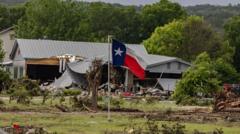Kerrville's Police community services officer, Jonathan Lamb, struggled to address the seriousness of the situation during a recent press conference, responding to questions about a potential police radio failure with “I don’t have any information to that point.” This silence follows an event that has become a tragic marker for the community: a rapid rise in the Guadalupe River due to excessive rainfall, with the area receiving an estimated 100 billion gallons of water, resulting in flash floods that overwhelmed the region.
Notably, the Kerr County Sheriff's Office did not send out the first alert until approximately 90 minutes after the rising waters had already begun to engulf local residents. An audio recording from a firefighter upstream indicated the urgency for alerts around 04:22 AM on the day of the floods, with requests to inform residents to seek higher ground, but there seemed to be bureaucratic delays in issuing the necessary warnings.
Kerr County Sheriff Larry Leitha acknowledged at a press conference that initial notifications were unclear, noting the need for a more concrete timeline. However, he emphasized that current efforts were directed towards locating missing individuals rather than addressing the communication failures. As of Thursday morning, over 160 people remained missing, including campers from a nearby Christian camp.
Authorities indicated that various factors contributed to the tragic outcomes of the floods, including poor cellular service, a misunderstanding of the storm’s severity, and a general desensitization to previous weather alerts among the communities in flood-prone areas.
Meanwhile, President Trump has declared a federal disaster in response to the crisis, enabling FEMA to assist in the recovery efforts in Central Texas. The search for missing residents continues, with over 2,100 responders, including private helicopters, boats, drones, and specialized search dogs working tirelessly amidst the hazardous conditions posed by mud and debris.
Experts are warning that the recovery will be a slow and dangerous process as the region deals with the aftermath of this unprecedented flooding. The ongoing situation calls for an urgent reassessment of emergency response strategies to prevent such tragedies in the future.
Notably, the Kerr County Sheriff's Office did not send out the first alert until approximately 90 minutes after the rising waters had already begun to engulf local residents. An audio recording from a firefighter upstream indicated the urgency for alerts around 04:22 AM on the day of the floods, with requests to inform residents to seek higher ground, but there seemed to be bureaucratic delays in issuing the necessary warnings.
Kerr County Sheriff Larry Leitha acknowledged at a press conference that initial notifications were unclear, noting the need for a more concrete timeline. However, he emphasized that current efforts were directed towards locating missing individuals rather than addressing the communication failures. As of Thursday morning, over 160 people remained missing, including campers from a nearby Christian camp.
Authorities indicated that various factors contributed to the tragic outcomes of the floods, including poor cellular service, a misunderstanding of the storm’s severity, and a general desensitization to previous weather alerts among the communities in flood-prone areas.
Meanwhile, President Trump has declared a federal disaster in response to the crisis, enabling FEMA to assist in the recovery efforts in Central Texas. The search for missing residents continues, with over 2,100 responders, including private helicopters, boats, drones, and specialized search dogs working tirelessly amidst the hazardous conditions posed by mud and debris.
Experts are warning that the recovery will be a slow and dangerous process as the region deals with the aftermath of this unprecedented flooding. The ongoing situation calls for an urgent reassessment of emergency response strategies to prevent such tragedies in the future.



















